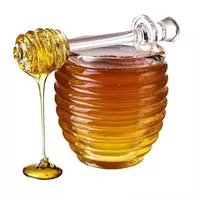Floral honey

Bee honey is a unique natural product that is nectar harvested and then processed by bees. The chemical composition of honey contains a large amount of various vitamins and useful compounds of natural origin. Since ancient times, people have used honey not only in cooking, but also in folk medicine. The unique beneficial properties of honey help in the course of many diseases.
Doctors advise eating honey not only for medicinal, but also for preventive purposes. Bee honey is classified according to various parameters. For example, the color, consistency, taste, aroma, geographical origin and of course the kind of natural material from which honey was derived are taken into account. Two main types of product are distinguished - paddy and floral honey. Honeybee honey is produced from nectar, which was obtained from the collection of sweet dew, which protrudes on the leaves and stems of plants.
Flower honey is based on nectar collected by bees from flowering nectaries and outside flowering plants. It is worth noting that both padena and floral honey are classified as incredibly valuable and healthy foods. It is worth noting that the taste, color, as well as the aroma and consumer characteristics of floral honey depend primarily on the type of plant whose nectar was processed by bees. Interestingly, the beneficial properties of floral honey also depend on the species of plant from whose pollen the product was produced.
Floral honey is divided into two main categories - polyflor and monoflor product. In the first case, flower honey was derived from the nectar of several plants. Monofloor flower honey is the result of processing nectar harvested from a single plant species. It is worth noting that it is quite difficult to get monofloor flower honey, since usually apiaries are located in the forest, where a large number of different plants grow.
As a rule, monofloor flower honey is called by the name of the plant, for example linden, buckwheat or chestnut honey. The following most common types of floral honey are distinguished: acacia, coriander, linden, diaglium, chestnut, sunflower, buckwheat, rapeseed, cranberry, willow, burdock, carrot, dandelion, mountain ash, cucumber, meadow and others. The beneficial properties of floral honey depend on the variety of product.
Floral honey is used as a natural and healthier sugar substitute. In addition, flower inter is used for the manufacture of confectionery, sweets, as well as sauces and culinary marinades. On the basis of floral honey, both alcoholic and non-alcoholic drinks are made, as well as healing infusions. Floral honey can become not only delicious, but also an incredibly healthy food in the diet of all family members.
floral honey 302.67 kCal
The energy value of flower honey (Ratio of proteins, fats, carbohydrates - ju):
Proteins: 0.27 g (~ 1 kCal)
Fats: 0 g (~ 0 kCal)
Carbohydrates: 80.1 g (~ 320 kCal)
Energy ratio (bj | y): 0% | 0% | 106%
 Español
Español Français
Français Português
Português Русский
Русский 简体中文
简体中文 繁體中文
繁體中文 日本語
日本語 한국어
한국어 العربية
العربية Türkçe
Türkçe Қазақ
Қазақ Deutsch
Deutsch Italiano
Italiano Українська
Українська
